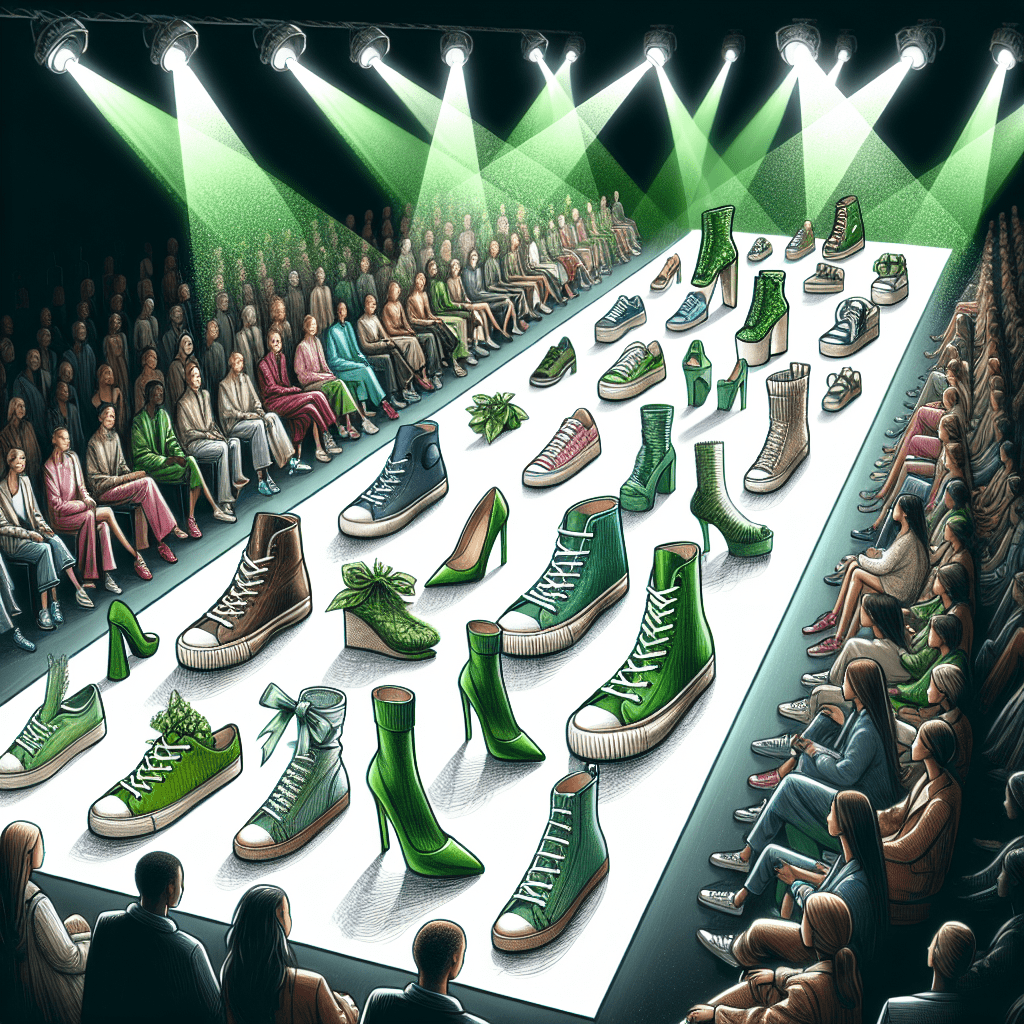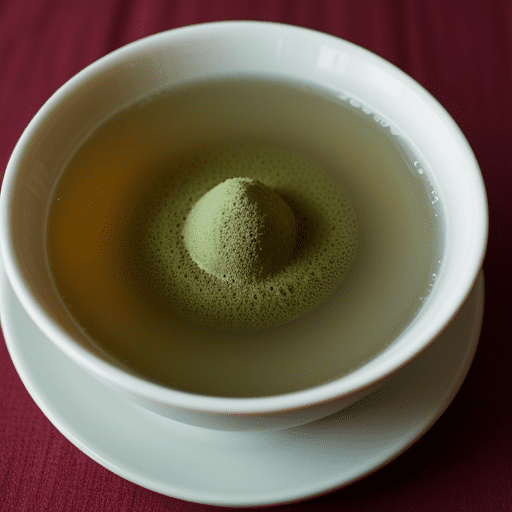Step Into Sustainability: The Rise of Green Shoes in Fashion

The fashion industry has changed a lot in recent years, which is mostly due to our increased awareness of environmental and ethical concerns. But one of the trendiest trends within this movement is green shoes, a development that features practically all kinds of footwear designed and constructed with sustainability in mind. Meanwhile, consumers are more and more eco-aware, with a corresponding mounting demand for solutions that echo concern. This change isn’t just a passing fad, but rather a major shift in which carbon footprint and sustainable living is becoming increasingly important. In this context, green shoes are an exceptional innovation that draws attention to recycled materials and renewable resources or ethically derived from the material component. This admits the progress on green production methods that help to reduce wastage and energy consumption. A light in the fashion industry that shows how style and sustainability can coexist, creating a path of inspiration for designers as well as consumers to join hands towards your greener future.
The Environmental Impact of Traditional Footwear
The resource-heavy manufacturing process and disposal of traditional footwear makes it have a rather large ecological footprint. Typical shoes are Iconic of materials such as leather, plastic (ie PVC), and other synthetic fibers that take a huge amount of energy water and chemicals to produce. This includes water pollution, deforestation—caused largely by leather production—and high carbon dioxide emissions from the inhumane livestock industry. Oil-based synthetics, such as polyester and nylon release microplastics into the water system during laundry — a significant threat to our oceans.
Not only that, the toxic adhesives and dyes used in manufactured fabrics can leach into soil and watersheds where they may pose health risks to humans systems if allowed to build up. Circling back to the end of life cycle, traditional shoes have a massive environmental toll as well. Almost no shoe wear is biodegradable and shoes are hard to recycle so large amount of waste goes to landfills where it takes some decades usually even centuries for them decompose, in worst case they release very harmful chemicals into the environment. The sustenance of adverse environmental impacts depends on a transition to sustainable footwear.
Carbon footprint of conventional shoe manufacturing
Conventional production methods—which have a significant impact on the environment—result in considerable carbon emissions from shoe manufacturing. Shoe production is highly resource dependent due to the use of non-renewable materials such as synthetic rubber, plastic and leather which have high environmental costs. Tanning leather uses harsh chemicals that can leach into water sources, and the manufacturing process for many synthetic materials is petroleum-based (which means its made of oil), a nonrenewable resource. Shoe factories are also high energy consumers, with many using fossil fuels to power their machines resulting in emissions of greenhouse gases. These raw materials, as well as the finished products are then transported across oceans and continents only to further compound carbon emissions with inefficient supply chains and wasteful packaging. Eventually, the traditional shoe space represents a notable portion of global carbon emissions as well-driven sustainable evolution is imperative. Alibaba Publishes Guide to Lower the Fashion Industry’s Carbon FootprintAhead of World Environmental Day, Alibaba Shows How Using Eco-Friendly Materials and Renewable Energy Can Cut Emissions (source:Alizila | 10/6/2021)How Recommended Reading阿里巴巴发布时尚行业碳减排指南为迎接世界环境日,今年的主题是气候变化[详细了解 ]何用好材料和应可再生能源削减网络上分享到:(六月十一日) —今天在联合国设立En…
Waste generated by non-recyclable materials
So much is non-recyclable and the speed of turnover in fashion contributes to a big pile of nasty, unbiodegradable waste. In traditional shoe manufacturing, this is often achieved by using synthetic materials like polyurethane, PVC (polyvinylchloride), and certain adhesives that are long-lasting arsenal against wear but incur severe environmental consequences. The problem, though, is that these materials can last for centuries in a landfill environment and release toxic substances into the soil when they do eventually decay (or get eaten by wildlife), thus destroying natural habitats & working their way up the food chain. Also, the burning with this kind of squander qualified prospects to air pollution so that as such — towards the environment and garden greenhouse pollutants. But the invention contributes to a recurring waste nightmare; in which millions of shoes are tossed each year, only adding fuel to an out-of-control global trash fire. Green shoes made of bio degradable/recyclable materials could also be a solution here. The emergence of green shoes represents a positive move toward sustainability, primarily reducing natural reliance and prioritizing eco-friendly production. This trend reduces waste and supports a circular economy, which designs products so that they can be used for generations by the same family, greatly benefiting both our planet and customers.
Chemical pollutants from dyes and glues
In the traditional shoe manufacturing, chemical pollutants due to dyes and glues are one of the most prominent environmental challenges that we face in today’s footwear industry. Most ordinary shoes are made of toxic chemicals: synthetic dyes and adhesives. This can in turn lead to water, soil and air contamination with these substances that are carcinogenic.
Dyes, in general contain heavy metals and other poisonous chemicals which if they leach out into waterbodies can affect marine ecosystem preached Satish. But unfortunately, these very chemicals also pollute our water through their production and disposal — damaging aquatic life as well as human health. These chemicals are volatile organic compounds (VOCs) that evaporate from glues and adhesives, polluting the air in factories where our clothes are made, while simultaneously putting workers at risk of exposure as well communities nearby.
On the other hand, green shoes are ones that obviously take into account sustainability by using natural threads or non-toxic dyes and adhesives. These alternatives have a much lower environmental footprint during production. Eco-friendly material usage for manufactures will help reduce chemical waste, and result in cleaner air and water quality-and overall healthier environment. This movement toward transparency in the footwear is not only about pollution but also part of a wider direction to apply more sustainable and ethical practices in our fashion manufacturing.
The Evolution of Green Shoes
Green shoes signal an important turning point in the path to sustainability for fashion as a whole. When it comes to the eco-friendly footwear brands of days past, designs were a bit more limited and not necessarily synonymous with great aesthetics (favored by environmental warriors at your local hippie commune). But the burgeoning awareness of environmental concerns and consumer interest in sustainable alternatives have spurred a wave of innovation. Simple Shoes and Patagonia were early pioneers who paved the way by using recycled materials, non-toxic dyes. Through the years, technological development and state of the art material sciences have made functional, beautiful green shoes a reality.
A combo of eco-friendly practices and on-trend designs have made shoes from brands like Allbirds and Veja the sustainable pieces everyone wants to wear. These brands use materials including merino wool, eucalyptus, organic cotton and recycled plastics to drastically decrease their carbon footprints. Not only that, but big athletic brands like Nike and Adidas are hopping on board as well putting sustainability first in full mainstreams of their product lines. This continued evolution epitomized a wave of change within the fashion industry, with an increased focus on style as well as environmental preservation.
Early beginnings and pioneering brands
Eco-friendly footwear began with the sustainable eco movement of the late 20th century, as environmental concerns pushed consumer habits and industry trends towards a greener path. Cult labels Veja and Stella McCartney led the way with a sharper focus on sustainable materials, eco-friendly packaging, or even in ecoresponsible production. Founded in 2004, Veja built a reputation using organic cotton and Amazonian wild rubber from fair-trade sources as well recycled plastics. On the other hand, Stella McCartney’s namesake brand — founded in 2000/01 — from its inception leaned into cruelty-free ethos using materials like vegetarian leather and recycled polyester. These brands were pioneering in that they showed the world, style and sustainability could go hand-in-hand. Their pioneers work made it possible for other companies to begin their exploration of the green in fashion. Their echo is heard in the brands of today, with sustainability transforming shoe fashion into a new shape wearing their industrial origins on its sole.
Technological advancements in sustainable materials
One of the biggest factors facilitating green shoes in fashion is incredible technological breakthroughs in sustainable materials. Bio-based and recycled fiber innovations lead this evolution, helping brands manufacture shoes with drastically smaller environmental footprints. Companies are using materials like Piñatex, pineapple leaf fiber and Mylo, leather alternative made from mycelium (mushroom roots) to make sustainable shoe products. Advances in recycling technology is also allowing plastic waste to be turned into high-performance fabrics, and likewise recycled midsoles. In addition to materials, 3D printing enables very accurate on-demand manufacturing which reduces waste and overproduction. In addition to that, waterless dyeing technologies and non-toxic adhesives are also making shoe manufacturing environmentally friendly. Using these sorts of technological advancements that are sustainable in and of themselves has made eco sneakers incredibly available, durable and much higher performance for the eco-friendly consumer thus accelerating this trend towards green fashion.
From niche to mainstream: Market growth and consumer demand
The green shoe industry has transformed from a niche market into an important mainstream trend over the past decade. What began as a niche product catering to the desire of environmentally conscious consumers has exploded in growth thanks to growing global awareness about environmental concerns and ethical means of production, and not a moment too soon. According to market reports, the eco-friendly shoe industry is now racking up record numbers driven by consumers’ increasing preference for products that balance style and environmentalism. Now, however, he has caught the eye of some major fashion brands which are incorporating recycled plastic and organic cotton in conjunction with naturally-sourced leathers into their lines. Additionally, the progression of eco-friendly manufacturing techniques has made products like SEMs more available and economical to everyday people. Recent years of social media and influencer endorsements have only served to solidify this movement, enlightening more people on how they can make eco-friendly fashion decisions from their own closets. The ever increasing dominance of green shoes proves these are fast becoming a vital component in the global footwear industry.
Innovative Materials and Techniques
Green shoes are created using avant-garde materials and methods in an attempt to minimize environmental effects. More and more brands are finding ways to incorporate sustainable materials into their collections, including organic cotton, hemp and textiles that biodegrade like Piñatex from pineapple leaf fibers. Also picking up steam is the adoption of recycled plastics and rubber from marine waste as well used tires. These materials also diminish reliance on virgin resources, and reduce waste.
Furthermore, there is a need for advanced methods of manufacturing shoe. This is because 3D printing helps conserve material and lessen scraps, through pinpoint accurate usage of materials to perfectly tailored designs that ultimately make products last longer. In addition, instead of toxic chemicals typically used in shoe production (asbestos from older pairs), water-based adhesives and non-toxic dyes are employed to protect workers as well the environment. Modular designs, in addition to being more sustainable than alternatives such as glued-together shoes or single-process moulding (which leads to recycling difficulties), can lead not only the easier repairs but also disassembly for better real-world waste collection prior dismantling of footwear that would otherwise go through an end-of-life landfill. This shows that the fashion industry is moving to a greener and more sustainable earth than ever, by embedding these new materials & techniques it opens great possibilities of having eco-friendly clothes.
Recycled plastics and ocean waste
A major breakthrough in the eco-friendly-focussed world of old-soled footwear is across new recyclable plastics and ocean waste. This sustainable solution helps to combat the growing problem of plastic pollution (especially in our ocean). Companies are working to collect discarded plastic materials — everything from bottles and containers left in the streets or delivered at beaches, fishing nets shed on ocean beds — which they then convert into shoes that avoid polluting our planet. With the help of state-of-the-art recycling processes, these plastics are then disintegrated and reworked into fibers as well as textiles that go in turn towards creating trendy cloth shoes. Such a process not only helps in ocean cleaning but also brings down the need for virgin materials, and fossil fuels which drastically reduce carbon footprint. Additionally, utilizing trash from the ocean in their shoe production spreads the idea of marine conservation down to its very fabric. With consumers increasingly concerned about the environment, there’s likely only more of these soulful vegan shoes to come packing a greater punch in both fashion and eco-friendliness.
Organic and plant-based materials
The use of natural and plant-derived materials in the production emphasizes a growing trend towards sustainability in fashion. Organic cotton, certified hemp and bamboo fibers join next-gen picks like Piñatex (an alternative to leather sourced from pineapple leaves) and Mylo (a mycelium-derived material made from the root structure of fungi). Not only are these options renewable, (and when unprocessed: biodegradable) but also have a much lesser environmental footprint than traditional leather and synthetic alternatives as result reduce water usage, pesticide use and carbon emissions. These also resonate with an eco-conscious initiative, which has values in transparency and ethical sourcing for brands who utilize them. Aboud adds that this movement caters to more environmentally conscious consumers and helps in pushing for wider adoption. What we get in return is a trendy and green sustainable choice that encompasses durability, comfort & style along with the power to influence others on sustainability considered important for all walks of life. These are small, but significant footprints in the path to a greener future for our footwear industry.
Eco-friendly production processes
That thinking is beginning to change as eco-friendly production processes are disrupting the fashion landscape, putting sustainability and environmental integrity at a premium. You can see this change even more noticeably in the world of footwear as companies are looking for greener production methods. These processes usually use sustainable materials as organic cotton, recycled plastics and natural rubber — which reduces the production footprint a lot. Moreover, environmentally friendly production focuses on energy-efficient methods and the use of alternative sources such as solar power and wind to reduce greenhouse gases.
As another critical factor, water conservation is also considered by many manufacturers who are now moving to closed loop systems that reprocess and reuse their production waters. Additionally, inks that are water-based and non-toxic as opposed to harmful chemicals also help make a difference with regards to polluting the environment along side while protecting workers from health problems.
They are also adopting transparent supply chain practices, guaranteeing fair labor conditions and reducing waste by designing shoes that can be taken apart and recycled. Fashion industry is taking strong steps towards a sustainable future by following these eco-friendly practices.
Benefits of Choosing Green Shoes
Choosing green shoes, produced following sustainable and eco-friendly processes offers more advantages than just fashion appeal. The biggest being, they greatly lessen the environmental impact of footwear manufacturing by reducing waste, lessening toxic chemicals used and conserving natural resources. Using eco-friendly materials — when compared to traditional methods of production, such as leather for example; garments made from organic cotton or recycled plastics emit fewer pollutants and less carbon. Moreover, green shoes are generally the product of ethical manufacturing practices that safeguard worker welfare and protect human rights. This is a model that enhances socio-economic sustainability from source to production. Also, when you choose to buy green shoes, it send a message to manufactures that consumers want more environmentally friendly options and they will shift their practices to meet higher consumer standards. The likes of those who are aware gain: the personal satisfaction that comes from living according to one’s principles; a small but important feeling that they have done something right in helping look after both themselves and their planet. The cumulative effect of these advantages is already a significant move toward making the fashion industry more sustainable and responsible.
Reduced environmental footprint
This will actually cut the environment off by large margin in multiple ways; like green shoes fashion. Since the traditional shoe manufacturing process is bad for many reasons — uses tons of water, chemicals and synthetic materials to pollute out rivers and oceans with waste. On the contrary, green shoes focus on sustainability from initial step. These products use materials like recycled plastics, organic cotton or sustainably-sourced natural fibers to lighten the load on non-renewable resources. Many models will be made from energy-saving processes and with lower emissions as well, helping to reduce their overall carbon footprint. Green shoes even consider the end-of-life phase by being biodegradable and recyclable, so they do not wind up in landfills. In addition, ethical production means that labor was more fair and socially less impactful. As consumers become more educated and demanding for greener products, this newfound trend we are observing with green shoes is instigating a paradigm shift towards sustainability in the industry whereby brands have to evolve their processes otherwise they will be left behind.
Ethical labor practices and fair trade
Our only saviour in the sad and unfortunate struggle of green shoes finding its place within this overly challenging fashion industry…?? The answer is- ethical labour practices & fair trade. With greater pressure from consumers for transparency and social responsibility, brands are thus forced to evaluate their supply chains. Ethical labor practices require that workers involved in green shoes production are treated fairly, receive living wages and work under safe conditions. In turn, this also enhances the lives of artisans and factory workers and eliminates exploitative labor practices that have tainted the fashion industry for years on end.
Fair trade certification also secures that these efforts are met with strict standards to ensure fairer trading conditions and ultimately social, economic sustainability. Brands that uphold fair trade standards work directly with producers to ensure they receive more equitable pay to cover the costs of productionimators. It becomes a cycle whereby sustainable communities breed quality green shoes. It goes wow by ensuring ethical labor practices and fair trade, as we see the fashion industry taking directions towards a more sustainable & humane future.
Long-term cost savings through durability
Green footwear is sustainable to provide long term durable cost saving investments even beyond eco-friendly elements. The process of mass production that is used with traditional footwear has inclined companies to utilize cheaper materials and methods over things like longevity. On the other hand, green shoes focus on sustainability — using only recyclable and biodegradable materials like organic cotton, recycled plastic and leather from certified environmentally responsible tanneries. Made to be more durable than traditional materials, these form the backbone of a shoe that will last you years.
In addition, sustainable brands often use fine woodworking that comes with a lifetime expectation of toughness. The outcomes are shoes, which sturdy and attractive even after continual use. As a result consumers are buying fewer replacements and not paying into repair bills, for green shoes however over its lifetime the consumer should spend much less. This means that choosing to wear durable, sustainable footwear has the potential of saving individuals in a large chunk in spending and aiding the environment through supporting matters such as environmental preservation but also short-circuiting fast fashion waste cycle.
So what have we concluded?
Overall, the green footwear trend and growth of fashion shoes as a facet in ‘Step Into Sustainability’ signifies a massive change toward improved environmental consumer habits and industry actions. This isn’t just a passing fad; it reflects an increasing dedication to sustainability in production, materials and business ethics designed around helping our planet. Forward thinking brands have been at the forefront of this movement, redefining style in combination with an entirely fresh standard for Corporate Responsibility. The consumer shift towards sustainability aligns with a larger trend in the industry, responding to companies needing more transparency and ethical practices. The inception of green shoes, therefore represent an awesome intersection between innovation, sustainability and style providing a beacon for the future to be hopeful seeing — not only does new fashions need some sacrifice out of nature. Such a revolution in fashion could gradually set to the entire conventional system, developing an eco-friendly ecosystem existing not merely within footwear but on both sides of production and consumption.







